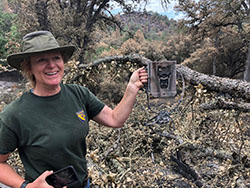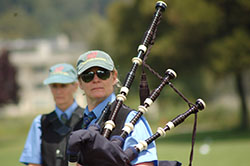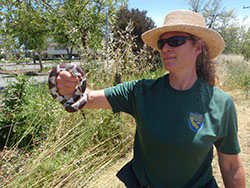
One of several burned trail cameras Martinelli lost in the Knoxville Wildlife Area as a result of the County Fire in July 2018.

Martinelli on the bagpipes

Martinelli holds a kingsnake from the Santa Rosa Plain Vernal Pool Ecological Reserve in Sonoma County
Stacy Martinelli is CDFW’s wine country wildlife biologist. An environmental scientist based in Santa Rosa, Stacy is assigned to Napa and Sonoma counties where she has worked the past 10 years conducting wildlife research, resolving human-wildlife conflicts and helping manage CDFW’s properties.
Stacy was born and raised in Montreal, Canada. She earned an undergraduate degree in wildlife management from Montreal’s McGill University and a master’s degree in wildlife ecology, also from McGill. For her graduate research, she studied black ducks in Nova Scotia, one of Canada’s Maritime provinces on the Atlantic Coast.
What brought you to the United States?
Work – like every immigrant. I just couldn’t find work in Canada so I answered an ad in an ornithological newsletter looking for help on a waterfowl research project down in Los Banos. I was like, “I’ll do that. That’ll be fun. I’ll just start building my résumé.” It was a six-month contract helping a graduate student from the University of Missouri with some research. The project ended and I thought, “I like California.” That was in 1995.
How did you get to CDFW?
After Los Banos, somebody knew somebody that needed a biologist for the Suisun Resource Conservation District (SRCD) in the Suisun Marsh. I spent three years in that job. I lived out in the barracks on Grizzly Island alongside CDFW employees. It was really a lot of fun. At SRCD, we worked closely with the department as well. So I knew people and how the department worked and I thought I would love to work for the department. I applied for a Habitat Conservation Program job in San Diego in 1988 and spent a year down there as an environmental scientist reviewing projects and issuing permits. I got a transfer and promotion to our Bay Delta Region and worked in our Timberland Conservation Program until 2008 when I got my current job.
What’s kept you in this job for the past decade?
It’s such a great job. I am so thankful for this job. It’s so variable. It’s a good mix of field work, research and monitoring. There’s a lot of hands-on work. Sonoma and Napa counties are really exceptional because there is just high biodiversity here and there is still a lot of open space. I am a little worried about the housing crunch and all the talk to build more housing but there’s still a lot of great wildlife habitat that’s out here. We’ve got the coast in Sonoma. In Napa, we’ve got the beautiful east side with the Knoxville Wildlife Area that’s still pristine. And even here on the west side of Santa Rosa, we’ve got (endangered) tiger salamanders. We’ve got neighbors around them, but they’re still here and that’s really cool. We’re trying to do everything we can to make sure they don’t disappear.
Last October, this region experienced some of the most devastating wildfires in U.S. history. You’ve had more fires this year. What’s been the impact to wildlife?
There was high mortality for sure, especially with the Tubbs Fire last year, which burned so quickly. The species that live here – bobcat, coyote, gray fox, blacktail deer – they’re fairly resilient and adaptable. I don’t worry about them on a population level. They are going to be fine.
I am working on two projects right now looking at fire effects. One of those is in the Knoxville Wildlife Area. This is year three of a camera trap study. It’s a way of measuring the wildlife community with cameras in terms of abundance and presence of different species and the balance among those species.
I’ve got 23 trail cameras spread out there in a grid pattern about a kilometer apart. I’ve got half of my cameras on the west side of the wildlife area and half of my cameras on the east side. The east side burned in July in the County Fire and I lost a bunch of cameras. They just melted. But some survived and I’ve got photos of the flames and the smoke and everything.
The cool thing is I have three years of baseline data so I know what the wildlife community looks like pre-fire and now we get to see what the wildlife community looks like post-fire. We actually talked to Cal Fire at one point about doing a prescribed burn to study this exact thing, and now 6,000 acres are gone as a result of the County Fire.
My hope is that we see a rejuvenation of the chaparral community because that stuff just gets super woody. Deer browse those shrub species and as they age and become woody, they lose their nutritional value. All the new growth is going to provide a wonderful new food source for them. I’m pretty excited about the whole thing.
It sounds like the Knoxville Wildlife Area is a pretty special place.
It’s a very important piece of property. I’m so lucky I get to work on it. It’s huge. It’s 22,000 acres of mostly oak woodlands and grasslands with the chaparral component. There’s not a lot of other public hunting land around here. If you’re a Bay Area resident, Knoxville is the closest place to hunt deer.
The funny thing is when I first started working there I was like, “OK, nothing lives here.” I never saw any wildlife. Maybe I would see a deer or two by the side of the road but even when I explored the backcountry, I never saw much of anything. It was like a dead zone. What lives here? I have no idea.
But we’ve found all kinds of wildlife with our camera study. We found bears, which I thought was cool. We knew there were mountain lions, but we wanted documentation. There are more deer there than I thought. We never used to see bucks. But then I got some cameras up in the high elevations, the mostly inaccessible areas and it was like, “Aha! I know where you are now!” We saw badger. We found roadrunner. We found spotted skunk. These are all species that would be really tough to see in the field. So it’s been really exciting.
Is there a particular project you’ve worked on over your career that you’re especially proud of?
I’m not sure I’ve done that signature project yet. To me, land conservation is the biggest contribution that I think I can make and we as a department can make. They’re just not making any more land. If we don’t get the land, there’s always the risk of development. I’m pretty passionate about land conservation for wildlife. So I’m waiting for that opportunity to be part of locking up a piece of land for the wildlife community – and for the public, too.
What advice would you give a young person thinking about a career in natural resources?
I think the best thing is to do as much field work as you possibly can – especially during your undergraduate studies. Volunteer. Get an internship. Just be active in the wildlife community as best you can.
We have students call us quite often and we hire a bunch of scientific aides. I’ve done a lot of interviews and looked at a lot of résumés. Unfortunately, we see people who have graduated from college without a stitch of field experience. They’ve not done one thing. Start padding your résumé and just be prepared the next couple of years to travel around and do field projects throughout the state, throughout the country, throughout the world. Eventually you will get there. But be patient because you have to suffer some horrible pay and eating Top Ramen for a while before you can latch onto something permanent.
Tell us something about yourself people would be surprised to learn.
I play bagpipes in a bagpipe band. I play with the Macintosh Pipe Band in Larkspur, Marin County, and I go down and practice every week. We compete in the Bay Area, Monterey, and have played across the U.S., Scotland and Mexico. I learned how to play in Canada and I’ve stuck with it ever since. It’s a passion of mine.
Photos courtesy of Stacy Martinelli. Top Photo: Martinelli searches Mount St. Helena in Napa County for deer fecal pellets as part of CDFW’s statewide deer population survey, which extracts DNA information from the pellets.